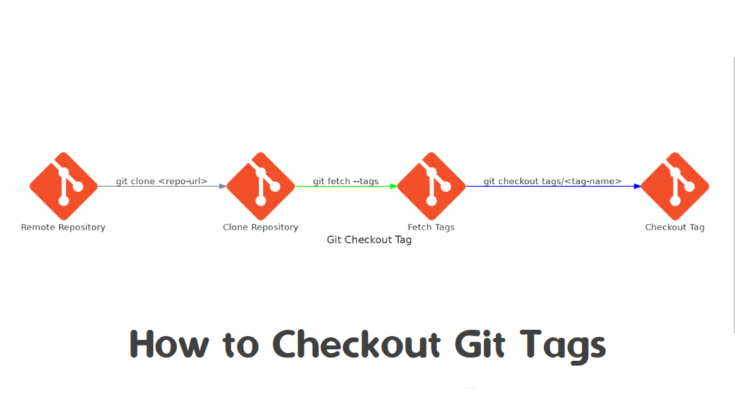Imagine you’re part of a software development team working on a project that has regular releases. Each release is marked with a Git tag, such as “v1.0” or “v2.1”. You need to investigate a bug reported in version 1.0, which is no longer the latest version. To do this, you need to checkout or clone the repository at the state it was in when version 1.0 was released. By using the tag “v1.0”, you can easily access the exact code and environment as it was at that point, ensuring accurate debugging and analysis.
This tutorial will guide you through the process of working with Git tags, ensuring you can effectively manage your project’s versions.
Table of Contents
Let’s dive in and streamline your Git workflow!
Creating Git Tags
Creating tags in Git is straightforward. Here’s how you can create both lightweight and annotated tags.
Annotated Tags
These tags store extra metadata such as the tagger name, email, date, and a tagging message. They are stored as full objects in the Git database.
To create an annotated tag, use the git tag -a command followed by the tag name and a message.
# git tag -a v1.0 -m "Initial release"This command creates an annotated tag named v1.0 with the message “Initial release”.
Lightweight Tags
These are simply pointers to a specific commit and do not store any additional metadata. Lightweight tags are created using the git tag command without any options.
# git tag v1.0-lightThis creates a lightweight tag named v1.0-light.
Listing Git Tags
To list all the tags in your repository, simply use the git tag command:
# git tagThis command will display all the tags in your repository.
v1.0
v1.0-lightListing Tags with Patterns
If you have a large number of tags and want to filter them based on a specific pattern, you can use the git tag -l command followed by a pattern. For example, to list all tags starting with “v”:
# git tag -l "v*"This will display all tags that start with the letter “v”. Using patterns can be especially helpful when dealing with many tags or when you want to find specific versions quickly.
v1.0
v1.0-lightUsing patterns can be especially helpful when dealing with many tags or when you want to find specific versions quickly.
Detailed Tag Listing
For a more detailed listing of tags, including their corresponding commit messages, you can use the git show-ref –tags command:
# git show-ref --tagsThis will list all tags along with their associated commit hashes and messages, providing a more comprehensive view of your tags.
efb7defa2e0930e3ff302f8e36b2b7ac4f68d70c refs/tags/v1.0
a13cd2e0942f7d36e8a9713ebdeab41d3fa1c5cd refs/tags/v1.0-lightDescribing Tags
The git describe command can be used to find the most recent tag in your repository and describe it. This is useful for identifying the latest tagged version of your project.
To find the most recent tag:
# git describe --tags $(git rev-list --tags --max-count=1)The above command finds the latest tag by first getting a list of all tags sorted by their commit date, then using git describe to get a human-readable name for the latest tag. This is particularly useful for continuous integration and deployment scenarios where you need to know the latest tagged version.
Fetching Remote Tags
Sometimes, you might need to ensure you have the latest tags from a remote repository. Use the git fetch –tags command to fetch all tags from the remote:
# git fetch --tagsThis command updates your local repository with the tags from the remote repository, ensuring you have the most up-to-date list.
Fetching tags from remote repository...
From https://github.com/user/repository
* [new tag] v1.0 -> v1.0
* [new tag] v1.0-light -> v1.0-lightChecking Out Git Tags
Once you have your tags, you might want to check out a specific tag to view the state of your project. Checking out a tag detaches your HEAD, putting you in a “detached HEAD” state.
# git checkout v1.0After running this command, your working directory will reflect the state of the project at the v1.0 tag. Remember, you are now in a detached HEAD state, meaning any changes you make will not be on any branch.
If you want to make changes, it’s a good practice to create a new branch from this tag.
# git checkout -b new-branch v1.0This command creates a new branch called new-branch from the v1.0 tag.
Cloning a Repository with a Specific Tag
Sometimes, you might want to clone a repository and directly check out a specific tag. To achieve this, use the —-branch option with the git clone command.
# git clone --branch v1.0 https://github.com/user/repository.gitThis clones the repository and checks out the v1.0 tag. Using the –branch option ensures you get the exact state of the repository at the specified tag.
Working with Remote Tags
When you push your tags to a remote repository, use the git push command followed by –tags to push all tags.
# git push origin --tagsThis will push all your local tags to the remote repository. To fetch tags from a remote repository, use the git fetch command.
# git fetch --tagsOutput.
Counting objects: 10, done.
Delta compression using up to 8 threads.
Compressing objects: 100% (5/5), done.
Writing objects: 100% (10/10), 1.43 KiB | 1.43 MiB/s, done.
Total 10 (delta 1), reused 0 (delta 0)
To https://github.com/user/repository.git
* [new tag] v1.0 -> v1.0
* [new tag] v1.0-light -> v1.0-lightDeleting Git Tags
If you need to delete a tag, you can use the git tag -d command for local tags and git push –delete for remote tags.
# git tag -d v1.0This deletes the v1.0 tag locally.
To delete a remote tag, run:
# git push origin --delete v1.0This deletes the v1.0 tag from the remote repository.
To https://github.com/user/repository.git
- [deleted] v1.0Conclusion
In this article, we covered the essentials of working with Git tags, including creating, listing, checking out, and cloning tags. Understanding how to manage Git tags is crucial for maintaining clear version histories and effectively managing project releases.
FAQs
1. How do I checkout a file from a tag in Git?
You can checkout a specific file from a tag using git checkout tag-name -- file-path command.
2. How do I checkout a tag without creating a branch?
You can checkout a tag without creating a branch by using: git checkout tag-name. This puts you in a detached HEAD state.
3. How to checkout a tag as a new branch?
To checkout a tag and create a new branch from it, use: git checkout -b new-branch-name tag-name.
4. Can I push a single tag to a remote repository?
Yes, use git push origin tag-name to push a specific tag.




